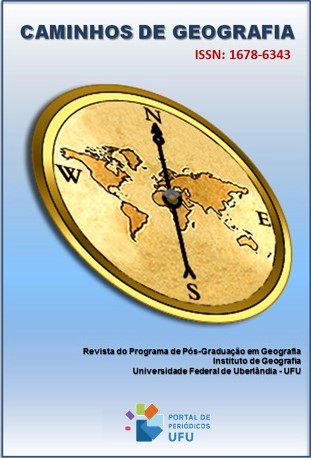DINÂMICA DA COBERTURA VEGETAL NO SEMIÁRIDO BAIANO: UM ESTUDO DE CASO DA BACIA HIDROGRÁFICA DO RIO DAS RÃS
DOI:
https://doi.org/10.14393/RCG249162327Palavras-chave:
Pressões antrópicas, Análise espacial, Vegetação, Agricultura regionalResumo
A bacia hidrográfica do rio das Rãs localiza-se no semiárido baiano, no contexto transicional entre os biomas Caatinga e Cerrado. Compreende uma síntese dos aspectos regionais, ambientais e atuações antrópicas do semiárido baiano. Ao longo das últimas décadas a bacia foi submetida a uma série de pressões antrópicas, levando-a a uma perda expressiva de vegetativo natural. Nesse contexto, o objetivo da pesquisa foi analisar a dinâmica espaço-temporal da cobertura vegetal em tipos de vegetação de Cerrado e Caatinga, da bacia hidrográfica e seu entorno, entre as os anos de 1970 e 2019. Para compreender a dinâmica da cobertura vegetal, no espaço e tempo, fez-se o uso das técnicas do sensoriamento remoto e do geoprocessamento. Nesse período, a redução da cobertura vegetal foi de 360.684,97 ha (18% da área do estudo), sendo que os primeiros 14 anos registraram as maiores diminuições. Os maiores remanescentes de vegetação localizam-se em áreas remotas (afloramentos rochosos/relevos residuais). Observou-se redução significativa da vegetação em áreas de Cerrado e Caatinga, ultrapassando a capacidade dessas fitofisionomias em suportarem pressões antrópicas. O que proporcionou a alteração do uso da terra foi, principalmente, os períodos prósperos da agricultura regional (plantio de algodão) e a prática do carvoejamento ilegal.
Downloads
Downloads
Publicado
Edição
Seção
Licença
Copyright (c) 2023 Carlos Magno Santos Clemente, Alecir Antônio Maciel Moreira

Este trabalho está licenciado sob uma licença Creative Commons Attribution-NonCommercial-NoDerivatives 4.0 International License.
Autores que publicam nesta revista concordam com os seguintes termos: a) Autores mantém os direitos autorais e concedem à revista o direito de primeira publicação, com o trabalho licenciado sob a Creative Commons Atribuição-NãoComercial-SemDerivações 4.0 Internacional. b) Autores têm permissão e são estimulados a publicar e distribuir seu trabalho online (ex.: em repositórios institucionais ou na sua página pessoal), já que isso pode gerar alterações produtivas, bem como aumentar o impacto e a citação do trabalho publicado. c) Em virtude de aparecerem nesta revista de acesso público, os artigos são de uso gratuito, com atribuições próprias, em aplicações educacionais e não-comerciais.











